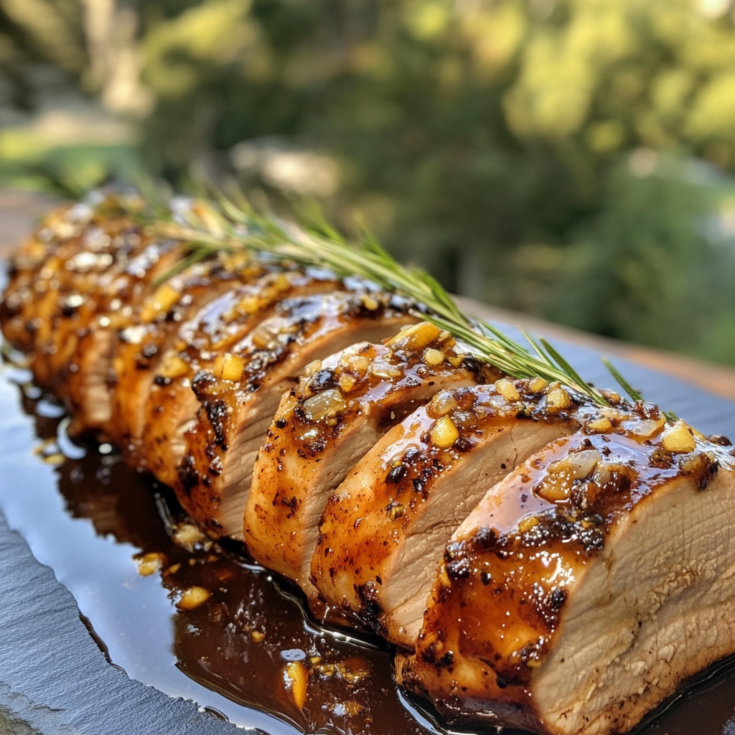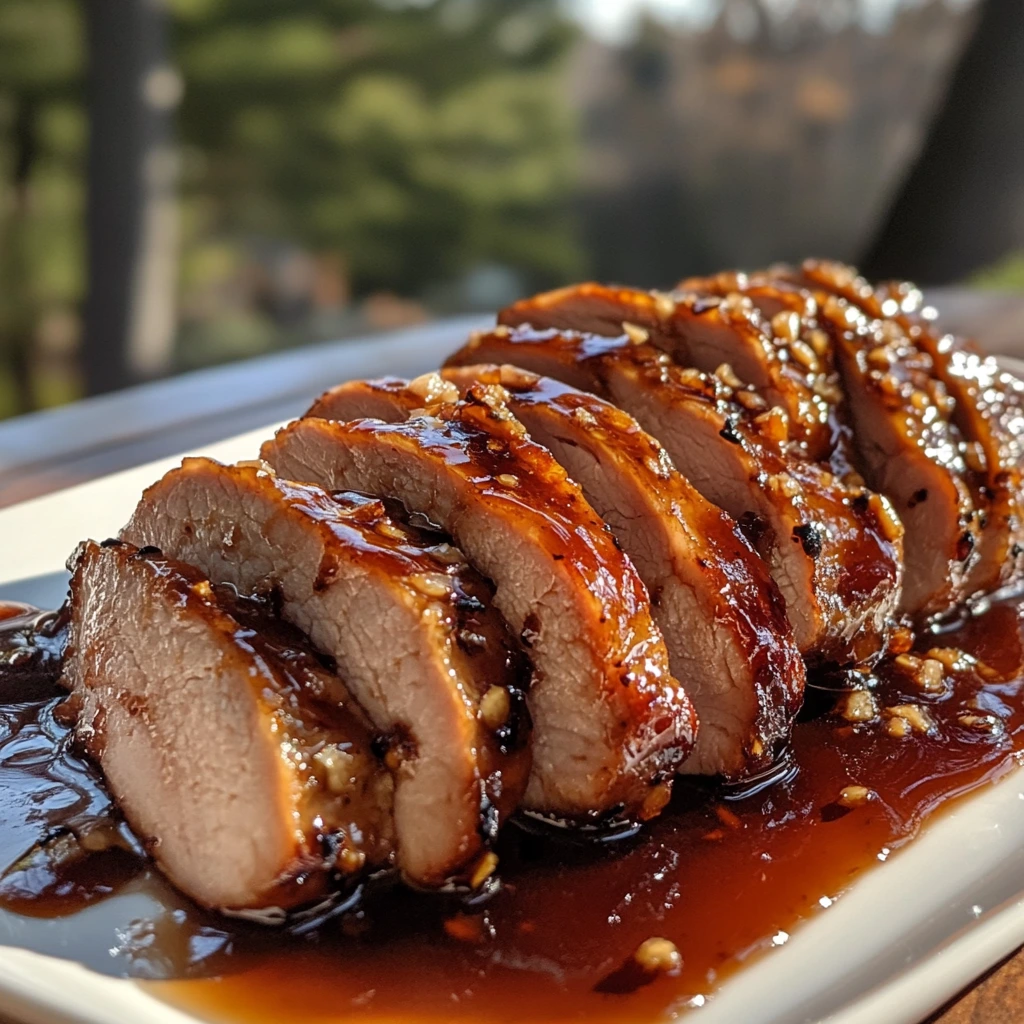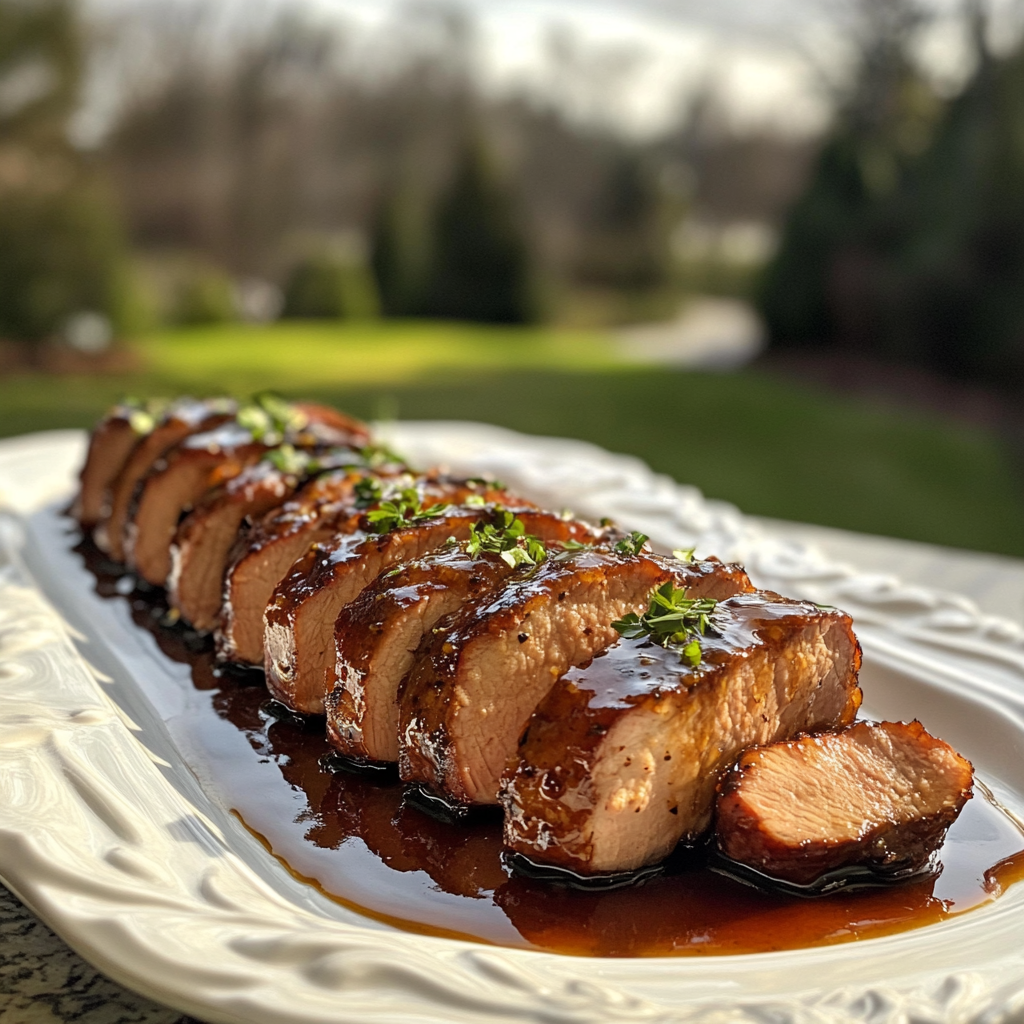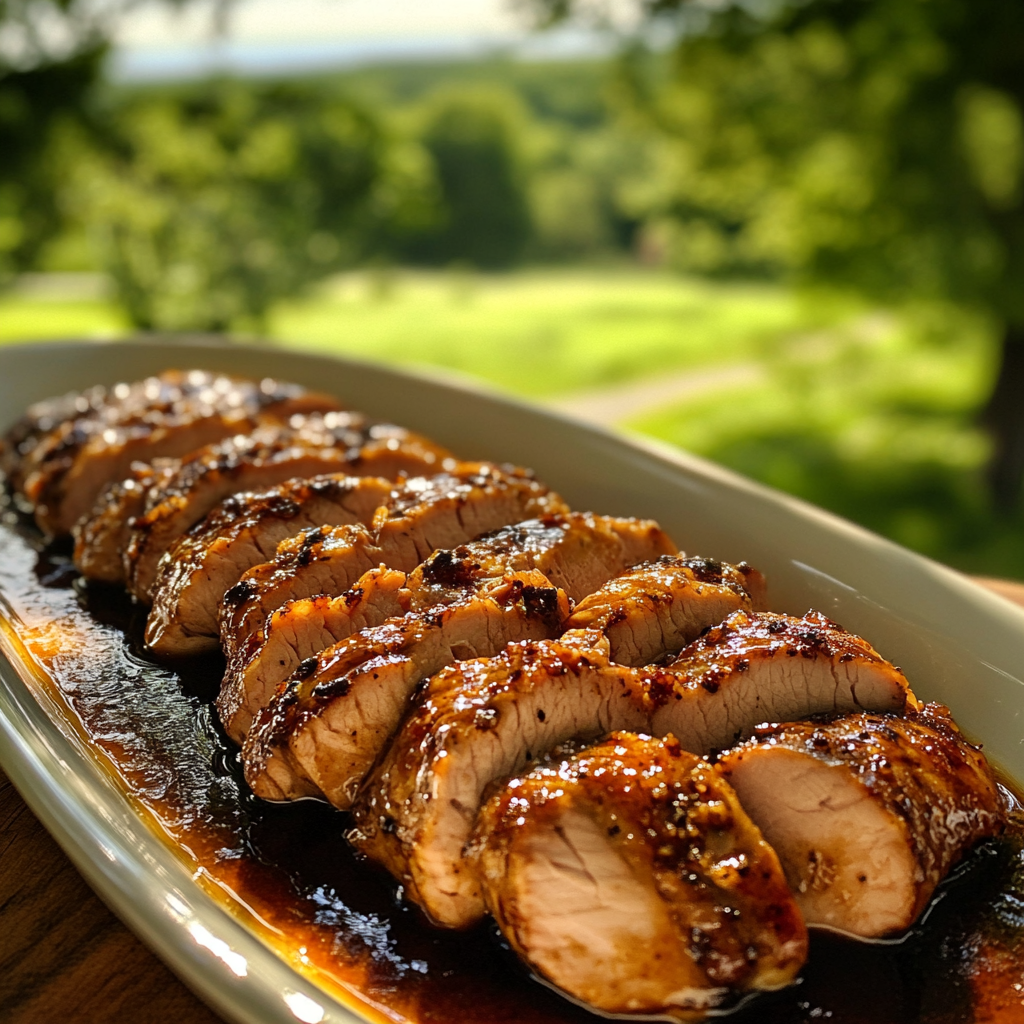Brown Sugar Pork Tenderloin Glaze: A Sweet and Savory Delight
Few flavor combinations compare to the rich harmony of brown sugar and pork tenderloin. The sweetness of caramelized sugar meets the savory depth of perfectly cooked meat. It’s a match made to impress every time it hits the table.
Brown sugar glaze adds more than just taste—it transforms the entire dish. Whether you’re roasting, grilling, or slow-cooking, this glaze brings moisture, color, and a glossy finish that looks as good as it tastes. It’s versatile too. With a few simple tweaks, you can tailor it for any cooking method or flavor preference.
In this article, we’ll dive into the secrets behind a great brown sugar glaze. You’ll learn how to choose ingredients, prep your tenderloin, and apply the glaze like a pro. Ready to turn a simple dinner into a show-stopping favorite? Let’s get started.
What Makes Brown Sugar Glaze Special?
A brown sugar glaze delivers a mouthwatering blend of sweet and savory flavors. When it touches hot pork tenderloin, the sugar melts and caramelizes. This creates a deep, golden crust that’s rich with flavor and full of contrast.
The glaze doesn’t just sit on the surface—it seeps into the pork, enhancing every bite with a sweet tang. It balances perfectly with the natural savoriness of pork, creating a flavor harmony that’s hard to resist. This glaze is popular because it transforms a simple protein into a gourmet-style dish using pantry staples.
Key Ingredients in a Brown Sugar Glaze for Pork
-
Brown Sugar: The star ingredient. It melts easily and forms a thick, sticky glaze with hints of molasses.
-
Acidic Components: Balsamic or apple cider vinegar cuts through the sweetness, brightening the glaze with a slight tang.
-
Aromatics: Garlic, onion powder, mustard, and black pepper bring layers of depth and savory warmth.
-
Optional Enhancers: Honey or maple syrup adds richness. Soy sauce introduces umami and a touch of salt for balance.
These ingredients work together to make every bite bold, rich, and satisfying. The beauty of the glaze lies in its flexibility. You can adjust sweetness, spice, or tang to match your personal taste or cooking style.
Benefits of Using Brown Sugar Glaze on Pork Tenderloin
Brown sugar glaze isn’t just flavorful—it’s functional. It delivers taste, moisture, and stunning presentation, all in one simple step.
Moisture Retention
The glaze forms a protective layer that locks in juices during cooking. This keeps the pork tender and moist from the inside out, especially during high-heat roasting or grilling.
Flavor Enhancement
Sweet and savory flavors mingle beautifully in this glaze. It enhances the natural richness of pork without overpowering it. Every bite tastes balanced and full-bodied, satisfying even the pickiest eaters.
Visual Appeal
A glossy, caramelized glaze gives pork a beautiful finish. The rich color and sheen signal bold flavor before the first bite. It looks elegant on the plate and instantly upgrades your dinner presentation.
Oven-Roasted Brown Sugar Pork Tenderloin
Oven-roasting brings out the best in brown sugar glazed pork. It enhances the glaze, seals in juices, and creates a beautiful, caramelized finish.
Preparation: Marinate and Season for Maximum Flavor
Begin by trimming the pork tenderloin of silver skin. Whisk together your glaze ingredients—brown sugar, vinegar, garlic, mustard, and a pinch of pepper. For richer flavor, marinate the tenderloin in this mixture for at least one hour or overnight.
If short on time, brush the glaze generously over the pork and let it sit for 15 minutes while the oven preheats.
Cooking Steps: Searing and Baking for Juiciness
Preheat the oven to 375°F (190°C). Sear the tenderloin in a skillet over medium-high heat for 2-3 minutes per side. This locks in moisture and builds flavor. Transfer it to a baking dish or leave it in an oven-safe pan.
Bake uncovered for 20–25 minutes or until the internal temperature reaches 145°F (63°C). Brush with extra glaze halfway through baking for deeper flavor.
Tips: Temperature is Key
Use a meat thermometer to avoid overcooking. Insert it into the thickest part of the tenderloin. Rest the pork for 5–10 minutes after cooking to keep it juicy and tender.
Slow Cooker Brown Sugar Glazed Pork Tenderloin
The slow cooker makes this dish nearly effortless. It allows the glaze to soak deeply into the meat, delivering rich flavor in every bite.
Preparation: Build a Glaze for Low and Slow Cooking
Combine brown sugar, balsamic vinegar, garlic, mustard, and a splash of broth or water. This keeps the glaze from becoming too thick during the long cook.
You can sear the pork beforehand to enhance flavor, or skip this step for convenience.
Cooking Steps: Layer and Let It Simmer
Place the pork tenderloin in the slow cooker. Pour the glaze mixture over it. Cook on low for 6–8 hours or high for 3–4 hours, depending on your schedule.
About 30 minutes before it’s done, spoon the glaze over the meat again for extra richness.
Advantages: Set It and Forget It
This method is perfect for busy days. The glaze infuses slowly, creating melt-in-your-mouth texture. There’s no need to check often—just let it do its thing.
Grilled Brown Sugar Glazed Pork Tenderloin
Grilling adds a smoky edge to the sweet glaze and creates delicious char marks that boost flavor and texture.
Preparation: Marinade and Preheat for Success
Make your glaze with brown sugar, vinegar, garlic, and mustard. Marinate the pork for at least one hour to let the flavors absorb.
Preheat your grill to medium-high heat. Oil the grates to prevent sticking.
Cooking Steps: Master Heat Zones and Basting
Sear the tenderloin over direct heat for 2–3 minutes per side. Move it to indirect heat to finish cooking without burning the glaze.
Grill for another 15–20 minutes, turning occasionally. Baste with fresh glaze during the last 5–7 minutes to build a glossy layer without charring.
Flavor Profile: Bold and Smoky Finish
The grill brings out the glaze’s depth with smoky, slightly charred edges. The brown sugar caramelizes perfectly over the flame, giving each slice intense flavor and crisp texture.
Air Fryer Brown Sugar Pork Tenderloin
Want a quick method with crispy results? The air fryer delivers speed, texture, and bold flavor in every bite.
Preparation: Thicken and Apply Your Glaze
Use a slightly thicker glaze. Reduce vinegar or add a bit of cornstarch to keep it from dripping in the basket. Coat the pork evenly and preheat the air fryer.
Cooking Steps: Set It and Flip It
Cook at 400°F (200°C) for 20–25 minutes, flipping halfway through. Check the internal temperature near the end to make sure it reaches 145°F.
Brush with extra glaze during the final 5 minutes for a shiny, sticky crust.
Benefits: Speed and Crisp Perfection
Air frying locks in moisture while crisping the outside. It’s faster than other methods and still gives you that signature brown sugar glaze finish—golden, rich, and satisfying.
Flavor Variations for Brown Sugar Glazed Pork Tenderloin
One of the best things about a brown sugar glaze is how easily it adapts. Whether you like heat, herbs, or citrus brightness, simple tweaks can take your tenderloin to the next level.
Spicy Kick: Add a Little Heat
Balance the sweetness with a touch of spice. Crushed red chili flakes or a dash of hot sauce can awaken the glaze and add depth. Start small—a pinch of flakes or a teaspoon of hot sauce. You can always increase the heat based on your preference. This variation pairs well with roasted root vegetables or grilled corn.
Herb Infusions: Earthy and Aromatic
Fresh herbs bring a savory lift to the glaze. Rosemary adds piney notes, thyme gives a subtle earthiness, and sage brings a warm, peppery finish. Mix a teaspoon of chopped herbs into the glaze before cooking, or sprinkle them on just before serving. This version complements mashed potatoes and green beans beautifully.
Citrus Notes: Bright and Fresh
Citrus zest lightens the richness of brown sugar. Try adding orange or lemon zest to the glaze for a refreshing twist. Just a teaspoon can brighten the entire dish. The result? A lively flavor with just the right touch of sweetness and tang. This pairing works especially well with a side of wild rice or a crisp salad.
Pairing Suggestions to Complete the Meal
Serving your pork tenderloin with the right sides and extras enhances the entire dining experience. From hearty dishes to leftover reinventions, there’s no shortage of tasty companions.
Side Dishes: Round Out the Plate
-
Roasted Vegetables: Try carrots, Brussels sprouts, or sweet potatoes. Their caramelized edges echo the glaze’s sweetness.
-
Mashed Potatoes: Creamy potatoes soak up the glaze, adding comfort to every bite.
-
Steamed Rice or Quinoa: These grains make a neutral base that lets the pork shine.
Add a drizzle of leftover glaze to the sides for an extra pop of flavor.
Beverages: Pick Refreshing Complements
Skip the alcoholic pairings and lean toward non-alcoholic drinks that cleanse the palate and highlight the dish:
-
Sparkling apple cider for a crisp, fruity contrast
-
Ginger beer for a zesty kick
-
Iced herbal teas with lemon or mint for balance
These drinks amplify the glaze’s richness without overpowering it.
Leftover Ideas: Reinvent with Ease
Got leftovers? Don’t let them go to waste. The sweet and savory pork works in many next-day meals:
-
Sandwiches: Slice thin and layer on soft rolls with lettuce and slaw.
-
Salads: Dice and toss with greens, pecans, and a citrus vinaigrette.
-
Stir-Fries: Reheat with bell peppers and snap peas for a quick weeknight dinner.
Each of these options adds new life to your glazed pork, turning one meal into several.
FAQs About Brown Sugar Pork Tenderloin Glaze
Q1: How do I prevent the glaze from burning in the oven?
Apply the glaze during the final 10–15 minutes of cooking. This keeps the sugars from over-caramelizing or burning. Keep an eye on it, especially under high heat, and consider tenting with foil if browning too quickly.
Q2: Can I use white sugar instead of brown sugar?
White sugar can work, but it lacks the molasses content that gives brown sugar its rich, caramel flavor. Substituting it may result in a lighter taste and less depth in your glaze.
Q3: What internal temperature should pork tenderloin reach?
Pork tenderloin should be cooked to an internal temperature of 145°F (63°C). Let it rest for at least 3 minutes after removing it from heat. This ensures juicy, tender slices without overcooking.
Q4: Is it necessary to marinate the pork before applying the glaze?
While marinating boosts flavor and tenderness, it’s not a must. The glaze alone provides a powerful punch of sweet and savory notes. If time allows, even 30 minutes of marinating helps deepen the taste.
Q5: Can I prepare the glaze in advance?
Yes! Brown sugar glaze stores well. You can make it up to a week ahead and refrigerate it in an airtight container. Warm it slightly before applying to make it easier to spread.
Brown Sugar Pork Tenderloin Glaze

A succulent pork tenderloin coated in a sweet and savory brown sugar glaze. It’s easy to prepare and perfect for weeknight dinners or special occasions.
Ingredients
- 1.5 lbs pork tenderloin
- ½ cup brown sugar
- 2 tablespoons Dijon mustard
- 1 tablespoon soy sauce
- 1 teaspoon garlic powder
- Salt and pepper to taste
Instructions
Notes




